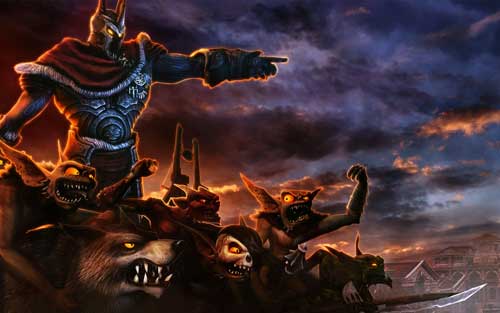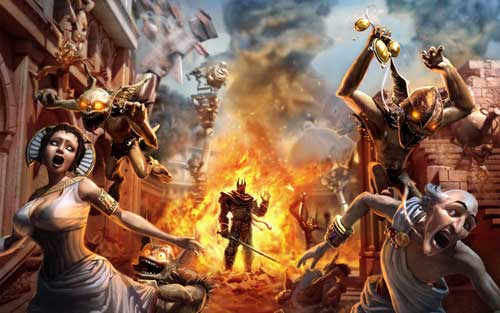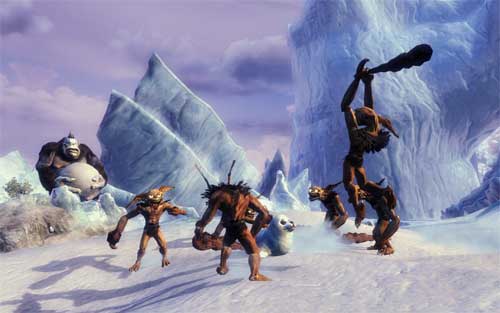
By Alan Cleaver
Controlling ghoulish minions in your attempt to overthrow the Greco-Roman “Glorious Empire” while you spread mayhem and leave a trail of destruction in your wake… what’s not to like? Overlord II provides a mixture of action, strategy, humor, and interactive gameplay to successfully appeal to its intended teenage demographic. It might be lost Elder-Geeks though.

The user controls the Overlord in the third person while commanding his legion of demonically-summoned minions to do his evil bidding. There are four different types of minions at the Overlord’s disposal: the browns, the reds, the blues, and the greens. Minions are summoned by the Overlord through the minion gates, which are located throughout each mission area. The number of minions held within the gates is dependent upon number of life-force orbs collected, which are left behind by fallen enemies. Each type of minion has its own strengths and weaknesses and even though you are able to utilize the Overlord in battle, he is best served acting as a general commanding his legion of minions to neutralize enemy forces.

When not conquering and pillaging, the Overlord retires to the Netherworld where you are able to rule and make decisions using the throne interface. The decisions that you make while ruling on your throne directly affect the gameplay and outcome of the story. One path will lead to the total destruction of the townspeople while the other path will enslave them, forcing them to worship you.
The gameplay is straightforward, taking minimal effort to master the controls while managing to provide somewhat challenging obstacles en route to completing various missions. This has its advantages and disadvantages. While it enables younger players to easily navigate the game and complete the missions, it might make the game seem borderline repetitive to older and more experienced players.
Despite what you would think, the game is lacking in graphical depictions of violence, as your fallen minions and enemies fade into the background without ever shedding a drop of blood; thereby contributing to the T for Teen rating. The game does have its socially interesting—if not humorous—parts as well. For example, in an early section of the game you have to command your minions to kill baby seals to obtain life-force orbs. That combined with tasks to decimate a population of garden gnomes all contribute to the overall feeling that this game is not to be taken seriously.

Overlord II does provide four different multiplayer scenarios, two cooperative and two versus. The multiplayer section of the game does not offer any new action for the game and seems as if it was hastily added on after the game’s completion. While it is a nice addition, it does not increase the replay value or overall appeal of the game.
In my mid-twenties, Overlord II is a fun game to play, but it gets a little repetitive pretty quickly. It’s clear that I’m not in Overlord II’s intended demographic. That being said, I think if I were 10 years younger, this game would have definitely kept me indoors. It’s a definite buy for young teenagers. For experienced gamers, it makes a great summer weekend rental.
About the Author: Alan is a pseudo nerd who usually spends his time playing sports games.
– – – – – – – – – – –
Overlord II
Published by: Codemasters
Developed by: Triumph Studio
ESRB: T for Teen
Platforms: PC, Playstation 3, Xbox 360
Release Date: June 23, 2009
Genre: Action / Adventure
